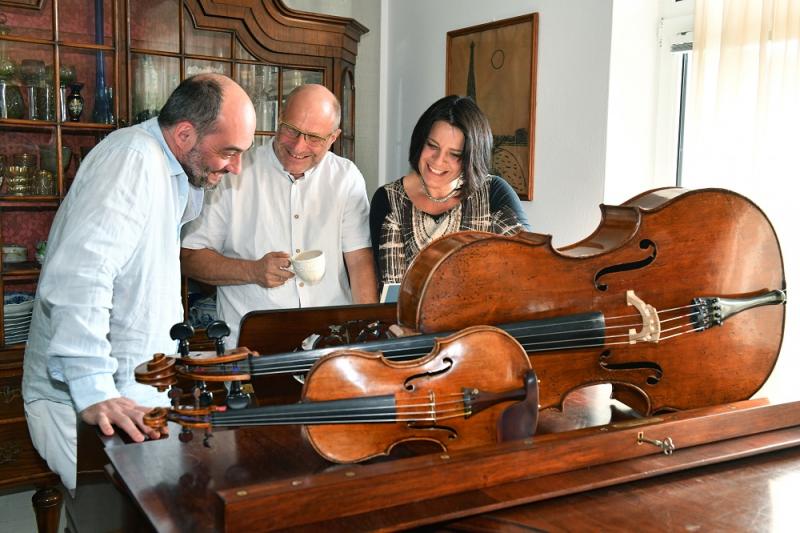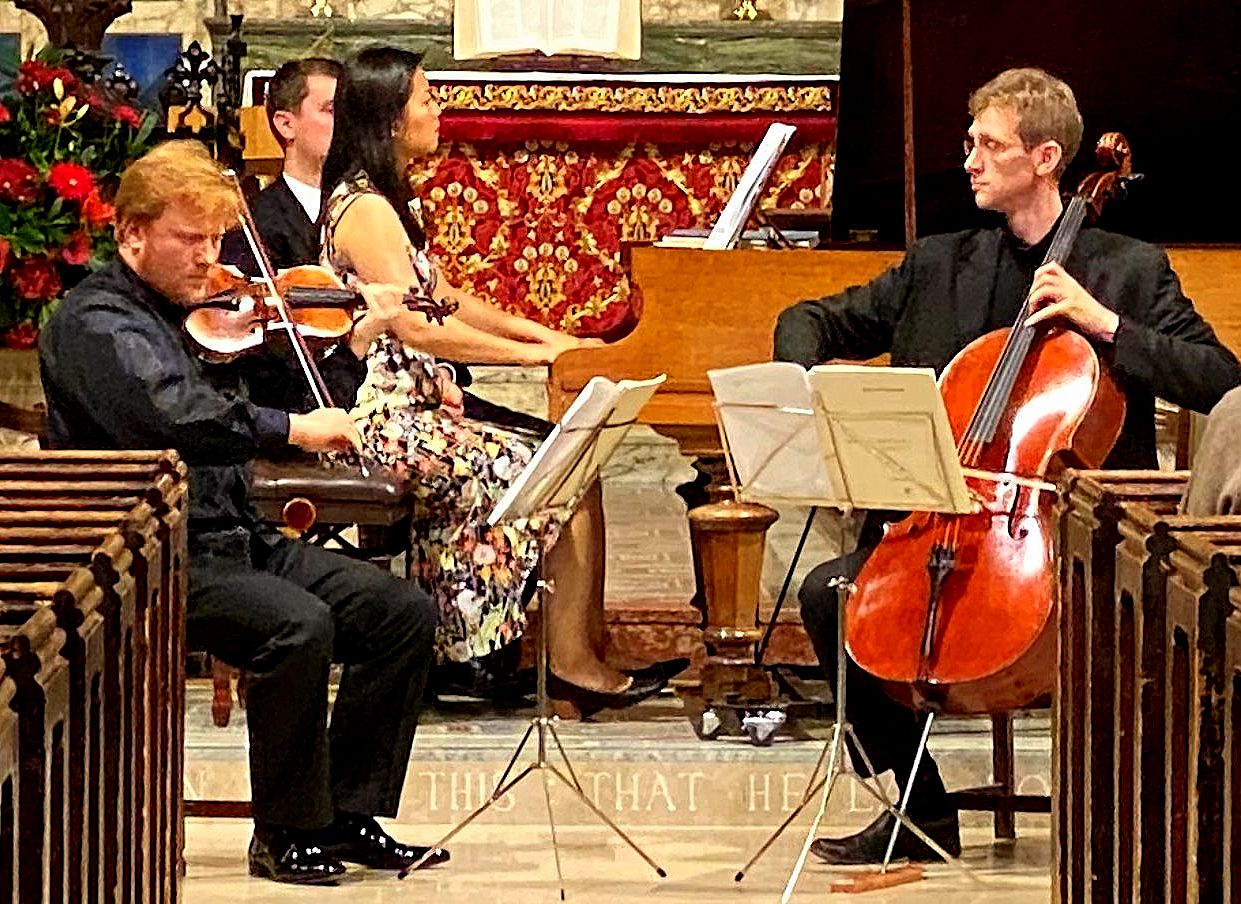Smetana Trio, Wigmore Hall / Minerva Piano Trio, Christ Church Kensington review - spirits of delight | reviews, news & interviews
Smetana Trio, Wigmore Hall / Minerva Piano Trio, Christ Church Kensington review - spirits of delight
Smetana Trio, Wigmore Hall / Minerva Piano Trio, Christ Church Kensington review - spirits of delight
Dazzling Beethoven and Dvořák, Schumann and Stravinsky from two engaging teams

Comparisons might have been odious between three of the world's most cultured players – pianist Jitka Cechová, violinist Jan Talich and cellist Jan Páleníček of the Smetana Trio – and the young, British-based Minerva Piano Trio (Annie Yim, Michal Ćwiżewicz and Richard Birchall).
Not a bit of it. Quotients of sheer joy were high in both the Wigmore Hall Sunday morning programme and the launch of a concert series in classy Christ Church Kensington, but if anything even higher in the Minerva’s double bill by virtue of an extraordinary, heart-overflowing masterpiece, Schumann’s Second Piano Trio in F, and cellist-composer Richard Birchall’s arrangements of movements – by no means all the usual suspects – from Stravinsky’s Pulcinella ballet. It’s typical of these players’ enterprise that this is their second ballet-music-for-piano-trio enterprise; I was sorry to have missed similar work, pre-pandemic, on Ravel’s Daphnis et Chloé with two dancers alongside the premiere of a work by colleague Cheryl Frances-Hoad in St John’s Smith Square.
Smetanas first, though. The sheer chameleonic stylishness of these Czechs, perhaps not as well known outside their homeland as they should be, was a joy to watch as well as hear from the first flourishes of Beethoven’s C minor Piano Trio Op. 1 No. 3. Transitions and shifts of shape and mood were immaculate. Talich looked not only inwards and across to his colleagues, but also outwards and upwards on a trill (I’m thinking of the one towards the end of the first-movement exposition, so eagerly awaited on the repeat) or a deft turn of phrase; Cechová seemed utterly at ease in crystalline spirit of delight; even the more outwardly reserved Páleníček humorously waved his bow with hair hanging loose at the end of an especially robust finale to Dvořák's Piano Trio No. 2 in G minor.
For me, it’s not as consistently breathtaking in its invention as either its predecessor or its two successors (though we got the last of the Fourth Piano Trio's five Dumky, best translated as "thought-pieces" in a Slavic tradition which moves from sadness to joy without transition, as encore). But the racy scherzo’s semitonal upward grinds were especially striking, and these players’ sophistication always keeps the obvious at bay. Next time, please, Martinů’s astounding Third Piano Trio, which a previous incarnation of the Smetana Trio with a different violinist has recorded to dazzling perfection.  Nothing could have prepared me for the rolling genius of the Schumann trio, though, usually overshadowed by its predecessor and certainly by the Piano Quartet and Quintet. Confession – I’d never heard it in concert, so this was like being greeted by the friendliest of world premieres. The inspiration seems to flow seamlessly, or so the Minervas presented it (Ćwiżewicz, Yim and Birchall pictured above last night), and when a quotation of the song “Dein Bildnis wunderselig” (“Your wondrous-happy image”) from the Op. 39 Liederkreis soars up from the action, time almost stands still – but not for long (as so often, Schumann couldn’t help interjecting his love for Clara). Seeming spontaneity conceals the highest art, but song is paramount – and what a complete one-off is the third movement, not so much waltz-like in feel as the briefly pensive walking gait of a thinker, with the sun coming out briefly and unexpectedly (like so much else in this masterpiece) towards the end. The finale is sheer exuberant joy. And the flow of the entire performance quickly made one forget the tonal shortcomings of the church Bechstein, not in the best of shapes.
Nothing could have prepared me for the rolling genius of the Schumann trio, though, usually overshadowed by its predecessor and certainly by the Piano Quartet and Quintet. Confession – I’d never heard it in concert, so this was like being greeted by the friendliest of world premieres. The inspiration seems to flow seamlessly, or so the Minervas presented it (Ćwiżewicz, Yim and Birchall pictured above last night), and when a quotation of the song “Dein Bildnis wunderselig” (“Your wondrous-happy image”) from the Op. 39 Liederkreis soars up from the action, time almost stands still – but not for long (as so often, Schumann couldn’t help interjecting his love for Clara). Seeming spontaneity conceals the highest art, but song is paramount – and what a complete one-off is the third movement, not so much waltz-like in feel as the briefly pensive walking gait of a thinker, with the sun coming out briefly and unexpectedly (like so much else in this masterpiece) towards the end. The finale is sheer exuberant joy. And the flow of the entire performance quickly made one forget the tonal shortcomings of the church Bechstein, not in the best of shapes.
There was so much bottled sunshine, too, in the Pulcinella selection, brilliantly shared between the three artists, with a focus on the trio of singers Stravinsky engages in his complete ballet. Virtuosic anger, too, in two explosions of quick-fire rage. But the final reiteration of happiness could not have been more emphatic. After that, wine in Growing Space's community organic garden outside the church, work on which Yim had cheerfully joined during lockdown, which led her serendipitously to wonder if the church itself might be a good venue for concerts. This was only the first of a promising series (though change the "k" back to "c", please, in "Christ Church Koncerts"), mixing lunchtimes and evenings. Give one of them a go – the atmosphere is welcoming.
- Next concert in the Christ Church series is on 24 November at 1pm, with Georgia Morse playing several of the Bach Cello Suites
- More classical reviews on theartsdesk
rating
Share this article
The future of Arts Journalism
You can stop theartsdesk.com closing!
We urgently need financing to survive. Our fundraising drive has thus far raised £49,000 but we need to reach £100,000 or we will be forced to close. Please contribute here: https://gofund.me/c3f6033d
And if you can forward this information to anyone who might assist, we’d be grateful.

Subscribe to theartsdesk.com
Thank you for continuing to read our work on theartsdesk.com. For unlimited access to every article in its entirety, including our archive of more than 15,000 pieces, we're asking for £5 per month or £40 per year. We feel it's a very good deal, and hope you do too.
To take a subscription now simply click here.
And if you're looking for that extra gift for a friend or family member, why not treat them to a theartsdesk.com gift subscription?
more Classical music
 Goldscheider, Brother Tree Sound, Kings Place - music of hope from a young composer
Unusual combination of horn, strings and electronics makes for some intriguing listening
Goldscheider, Brother Tree Sound, Kings Place - music of hope from a young composer
Unusual combination of horn, strings and electronics makes for some intriguing listening
 Helleur-Simcock, Hallé, Wong, Bridgewater Hall, Manchester review - moving lyricism in Elgar’s concerto
Season opener brings lyrical beauty, crisp confidence and a proper Romantic wallow
Helleur-Simcock, Hallé, Wong, Bridgewater Hall, Manchester review - moving lyricism in Elgar’s concerto
Season opener brings lyrical beauty, crisp confidence and a proper Romantic wallow
 Kohout, Spence, Braun, Manchester Camerata, Huth, RNCM, Manchester review - joy, insight, imagination and unanimity
Celebration of the past with stars of the future at the Royal Northern College
Kohout, Spence, Braun, Manchester Camerata, Huth, RNCM, Manchester review - joy, insight, imagination and unanimity
Celebration of the past with stars of the future at the Royal Northern College
 Jansen, LSO, Pappano, Barbican review - profound and bracing emotional workouts
Great soloist, conductor and orchestra take Britten and Shostakovich to the edge
Jansen, LSO, Pappano, Barbican review - profound and bracing emotional workouts
Great soloist, conductor and orchestra take Britten and Shostakovich to the edge
 Jakub Hrůša and Friends in Concert, Royal Opera review - fleshcreep in two uneven halves
Bartók kept short, and a sprawling Dvořák choral ballad done as well as it could be
Jakub Hrůša and Friends in Concert, Royal Opera review - fleshcreep in two uneven halves
Bartók kept short, and a sprawling Dvořák choral ballad done as well as it could be
 Hadelich, BBC Philharmonic, Storgårds, Bridgewater Hall, Manchester review - youth, fate and pain
Prokofiev in the hands of a fine violinist has surely never sounded better
Hadelich, BBC Philharmonic, Storgårds, Bridgewater Hall, Manchester review - youth, fate and pain
Prokofiev in the hands of a fine violinist has surely never sounded better
 Monteverdi Choir, ORR, Heras-Casado, St Martin-in-the-Fields review - flames of joy and sorrow
First-rate soloists, choir and orchestra unite in a blazing Mozart Requiem
Monteverdi Choir, ORR, Heras-Casado, St Martin-in-the-Fields review - flames of joy and sorrow
First-rate soloists, choir and orchestra unite in a blazing Mozart Requiem
 Cho, LSO, Pappano, Barbican review - finely-focused stormy weather
Chameleonic Seong-Jin Cho is a match for the fine-tuning of the LSO’s Chief Conductor
Cho, LSO, Pappano, Barbican review - finely-focused stormy weather
Chameleonic Seong-Jin Cho is a match for the fine-tuning of the LSO’s Chief Conductor
 Classical CDs: Shrouds, silhouettes and superstition
Cello concertos, choral collections and a stunning tribute to a contemporary giant
Classical CDs: Shrouds, silhouettes and superstition
Cello concertos, choral collections and a stunning tribute to a contemporary giant
 Appl, Levickis, Wigmore Hall review - fun to the fore in cabaret and show songs
A relaxed evening of light-hearted fare, with the accordion offering unusual colours
Appl, Levickis, Wigmore Hall review - fun to the fore in cabaret and show songs
A relaxed evening of light-hearted fare, with the accordion offering unusual colours
 Lammermuir Festival 2025, Part 2 review - from the soaringly sublime to the zoologically ridiculous
Bigger than ever, and the quality remains astonishingly high
Lammermuir Festival 2025, Part 2 review - from the soaringly sublime to the zoologically ridiculous
Bigger than ever, and the quality remains astonishingly high
 BBC Proms: Ehnes, Sinfonia of London, Wilson review - aspects of love
Sensuous Ravel, and bittersweet Bernstein, on an amorous evening
BBC Proms: Ehnes, Sinfonia of London, Wilson review - aspects of love
Sensuous Ravel, and bittersweet Bernstein, on an amorous evening

Add comment